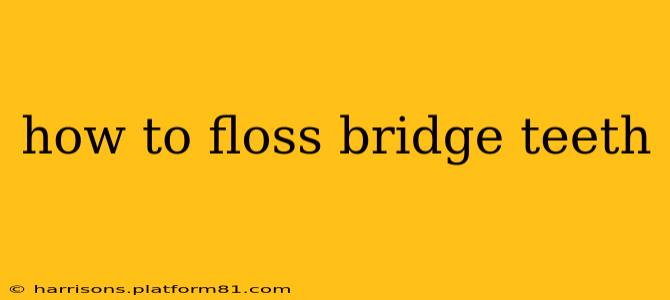Dental bridges are a fantastic solution for replacing missing teeth, restoring your smile, and maintaining proper oral health. However, cleaning around a bridge requires a slightly different approach than flossing natural teeth. Failing to clean properly can lead to gum disease, cavities, and even bridge failure. This guide will walk you through the best methods for flossing your bridge teeth effectively.
What Makes Flossing a Bridge Different?
The primary difference lies in the structure of the bridge itself. A bridge is essentially a prosthetic cemented to your existing teeth (abutment teeth). Traditional flossing techniques might damage the bridge's delicate structure or fail to clean effectively beneath it. The goal is to clean both the teeth supporting the bridge and the area beneath the pontic (the artificial tooth).
How to Floss Under a Dental Bridge: Step-by-Step
You'll need:
- Dental floss: Choose waxed or unwaxed floss—your preference will depend on your comfort level.
- Floss threader: This is crucial for reaching under the bridge.
- Interdental brushes: These tiny brushes can assist with cleaning between the bridge and gums.
Instructions:
- Thread the Floss: Carefully thread the floss through the floss threader.
- Gently Insert: Guide the threaded floss under the pontic (artificial tooth) of the bridge. Be patient and gentle; don't force it.
- Curve the Floss: Once under the bridge, curve the floss around the side of the abutment teeth (your natural teeth supporting the bridge).
- Up and Down Motion: Gently move the floss up and down against the gum line and the abutment teeth, ensuring you clean thoroughly.
- Repeat: Repeat steps 3 and 4 on the other side of the pontic. Use a fresh section of floss for each side.
- Interdental Brushes: After flossing, use an interdental brush to clean any remaining debris. Choose a brush size that fits comfortably under the bridge.
- Rinse: Thoroughly rinse your mouth with water or mouthwash.
What if I Can't Floss Under My Bridge?
If you find it challenging to floss under your bridge, don't be discouraged. Here are some alternatives and things to discuss with your dentist:
Using Different Flossing Aids:
- Super floss: This floss has a stiff end for reaching under bridges, followed by a spongy section for cleaning around the gum line.
- Water flossers (oral irrigators): These devices use a stream of water to clean between teeth and under bridges.
Seeking Professional Help:
- Regular Dental Checkups: Schedule regular checkups with your dentist for professional cleaning around your bridge. This is crucial for preventing problems.
- Consultation with your Dentist/Hygienist: If you're struggling, your dental professional can demonstrate the proper technique and recommend the best tools for your specific bridge.
How Often Should I Floss My Bridge?
Flossing around your bridge should be part of your daily oral hygiene routine, just like brushing your teeth. Aim to floss at least once a day, preferably before bed.
What are the Consequences of Not Flossing My Bridge?
Neglecting to floss your bridge can lead to several serious problems:
- Gum disease (gingivitis and periodontitis): Bacteria trapped under the bridge can cause inflammation and infection of the gums.
- Cavities: Food particles accumulating under the bridge can lead to tooth decay.
- Bridge failure: Poor hygiene can weaken the supporting teeth, increasing the risk of bridge failure and requiring replacement.
- Bad breath (halitosis): Bacteria buildup contributes to unpleasant breath.
Can I Use Regular Floss for My Bridge?
While you can attempt to use regular floss, it's often difficult to maneuver it effectively under the bridge. A floss threader is usually necessary to ensure thorough cleaning.
What Kind of Floss is Best for Bridges?
Waxed or unwaxed floss can both work, but many find waxed floss easier to slide under a bridge. Super floss is specifically designed for reaching hard-to-access areas like under bridges.
This comprehensive guide should help you maintain excellent oral hygiene around your dental bridge. Remember, proper cleaning is key to the longevity and success of your bridge and overall oral health. If you have any questions or concerns, consult with your dentist or dental hygienist. They can provide personalized guidance and ensure you’re maintaining optimal oral health.
